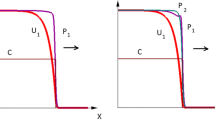Abstract
An isologous diversification theory for cell differentiation is proposed, based on simulations of interacting cells with biochemical networks and the cell division process following consumption of some chemicals. According to the simulations of the interaction-based dynamical systems model, the following scenario of the cell differentiation is proposed. (1) Up to some threshold number, divisions bring about almost identical cells with synchronized biochemical oscillations. (2) As the number is increased, the oscillations lose synchrony, leading to groups of cells with different phases of oscilaations. (3) Amplitudes of oscillation and averaged chemical compositions start to differ by groups of cells. The differentiated behavior of states is transmitted to daughter cells. (4) Recursivity is formed so that the daughter cells keep the identical chemical character. This “memory” is made possible through the transfer of initial conditions. (5) Successive differentiation proceeds.
The mechanism of tumor cell formation, origin of stem cells, anomalous differentiation by transplantations, apoptosis and other features of cell differentiation process are also discussed, with some novel predictions.
Similar content being viewed by others
References
Alberts, B., D. Bray, J. Lewis, M. Raff, K. Roberts and J. D. Watson. 1983 1989, 1994.The Molecular Biology of the cell. New York: Garland.
Chawanya, T. 1995.Prog. Theor. Phys.,94, 163.
Chow, M., A. Yao and H. Rubin. 1994. Cellular epigenesis: topochronology of progressive spontaneous transformation of cells under growth constraint.Proc. Nat. Acad. Sci. 91, 599–603.
Ganti, T. 1975.Biosystems,7, 189.
Goodwin, B. 1963.Temporal Organization in Cells. London: Academic Press.
Goodwin, B. 1982. Oscillatory phenomena in biochemistry.Ann. Rev. Biochem. 40, 237–258.
Kaneko, K. 1989. Chaotic but regular posi-nega switch among coded attractors by cluster size variation.Phys. Rev. Lett. 63, 219–224.
Kaneko, K. 1990. Clustering, coding, switching, hierarchical ordering, and control in network of chaotic elements.Physica 41D, 137–172.
Kaneko, K. 1991. Globally coupled circle maps.Physica 54D, 5–19.
Kaneko, K. 1992. Mean field fluctuation in network of chaotic elements.Physica 55D, 368–384.
Kaneko, K. 1994a. Relevance of clustering to biological networks.Physica 75D, 55–73.
Kaneko, K. 1994b. Chaos as a source of complexity and diversity in evolution.Artificial Life 1, 163–177.
Kaneko, K. and T. Ikegami. 1992. Homeochaos: dynamics stability of a symbiotic network with population dynamics and evolving mutation rates.Physica 56D, 406–429.
Kaneko, K. and T. Yomo. 1994. Cell division, differentiation, and dynamic clustering.Physica 75D, 89–102.
Kaneko, K. and T. Yomo. 1995. A theory of differentiation with dynamic clustering. InAdvances in Artificial Life, F. Moranet al. (Eds), pp. 329–340. Springer.
Kauffman, S. A. 1969. Metabolic stability and epigenesis in randomly connected nets.J. Theor. Biology 22, 437.
Kenyon, C. 1985. Cell lineage and the control ofCaenorhabditis elegans development.Philos. Trans. R. Soc. Lond. (Biol.) 312, 21–38.
Ko, E., T. Yomo and I. Urabe. 1994. Dynamic clustering of bacterial population.Physica 75D, 81–88.
Newman, S. A. and W. D. Comper. 1990. Generic physical mechanisms of morphogenesis and pattern formation.Development 110, 1–18.
Rubin, H. 1990. The significance of biological heterogeneity.Cancer and Metastasis Reviews 9, 1–20.
Rubin, H. 1994a. Cellular epigenetics: control of the size, shape, and spatial distribution of transformed foci by interactions between the transformed and nontransformed cells.Proc. Nat. Acad. Sci. 91, 1039–1043.
Rubin, H. 1994b. Experimental control of neoplastic progression in cell populations: Fould's rules revisited.Proc. Nat. Acad. Sci. 91, 6619–6623.
Sasa, S. and T. Chawanya. Weakly chaotic population dynamics in random ecological networks. Preprint.
Szathmary, E. and J. Maynard-Smith. 1995. The major evolutionary transitions.Nature 374, 227.
Volkov, E. L., M. N. Stolyarov and R. F. Brooks. 1992. The modelling of heterogeneity in proliferative capacity during clonal growth. InProceedings of the Lebededv Physics Institute: Biophysical Approach to Complex Biological Phenomena, E. Volkov (Ed), Vol. 194. Nova Publishers.
Yao, A. and H. Rubin. 1994.Proc. Nat. Acad. Sci. 91, 7712.
Author information
Authors and Affiliations
Corresponding author
Rights and permissions
About this article
Cite this article
Kaneko, K., Yomo, T. Isologous diversification: A theory of cell differentiation. Bltn Mathcal Biology 59, 139–196 (1997). https://doi.org/10.1007/BF02459474
Received:
Accepted:
Issue Date:
DOI: https://doi.org/10.1007/BF02459474




